Flexible, Low-Cost Sensor Based on Electrolyte Gated Carbon Nanotube Field Effect Transistor for Organo-Phosphate Detection
Abstract
:1. Introduction
2. Materials and Methods
2.1. Materials
2.2. Fabrication of CNTFET
2.3. Enzyme Immobilization Scheme
3. Results
3.1. Acetylcholine Sensor
3.2. Inhibition of Acetylcholinesterase Activity with the Organophosphate Malathion
3.3. Real Sample Analysis
4. Discussion
5. Conclusions
Supplementary Materials
Acknowledgments
Author Contributions
Conflicts of Interest
References
- Klaasen, C.D.; Ambur, M.O.; Doull, J. (Eds.) Casarett and Doull’s Toxicology: The Basic Science of Poisons; Macmillan: New York, NY, USA, 1986. [Google Scholar]
- Mineau, P. Cholinesterase-Inhibiting Insecticides: Their Impact on Wildlife And the Environment; Elsevier Science Ltd: Ottawa, ON, Canada, 2016. [Google Scholar]
- Dzudzevic Cancar, H.; Soylemez, S.; Akpinar, Y.; Kesik, M.; Göker, S.; Gunbas, G.; Volkan, M.; Toppare, L. A Novel Acetylcholinesterase Biosensor: Core-Shell Magnetic Nanoparticles Incorporating a Conjugated Polymer for the Detection of Organophosphorus Pesticides. ACS Appl. Mater. Interfaces 2016, 8, 8058–8067. [Google Scholar] [CrossRef] [PubMed]
- Tunçeli, A.; Baǧ, H.; Türker, A.R. Spectrophotometric determination of some pesticides in water samples after preconcentration with Saccharomyces cerevisiae immobilized on sepiolite. Anal. Bioanal. Chem. 2001, 371, 1134–1138. [Google Scholar] [CrossRef]
- Capitan-Vallvey, L.F.; Deheidel, M.K.A.; Avidad, R. Determination of carbaryl in foods by solid-phase room-temperature phosphorimetry. Fresenius J. Anal. Chem. 1998, 362, 307–312. [Google Scholar] [CrossRef]
- Daghbouche, Y.; Garrigues, S.; Delaguardia, M. Solid-Phase Preconcentration-Fourier Transform-Infrared Spectrometric Determination of Carbaryl and 1-Naphthol. Anal. Chim. Acta 1995, 314, 203–212. [Google Scholar] [CrossRef]
- Pogačnik, L.; Franko, M. Determination of organophosphate and carbamate pesticides in spiked samples of tap water and fruit juices by a biosensor with photothermal detection. Biosens. Bioelectron. 1999, 14, 569–578. [Google Scholar] [CrossRef]
- Tsogas, G.Z.; Giokas, D.L.; Nikolakopoulos, P.G.; Vlessidis, A.G.; Evmiridis, N.P. Determination of the pesticide carbaryl and its photodegradation kinetics in natural waters by flow injection-direct chemiluminescence detection. Anal. Chim. Acta 2006, 573–574, 354–359. [Google Scholar] [CrossRef] [PubMed]
- Yao, W.; Gao, Z.; Cheng, Y. Quartz crystal microbalance for the detection of carbaryl using molecularly imprinted polymers as recognition element. J. Sep. Sci. 2009, 32, 3334–3339. [Google Scholar] [CrossRef] [PubMed]
- Raeppel, C.; Nief, M.; Fabritius, M.; Racault, L.; Appenzeller, B.M.; Millet, M. Simultaneous analysis of pesticides from different chemical classes by using a derivatisation step and gas chromatography-mass spectrometry. J. Chromatogr. A 2011, 1218, 8123–8129. [Google Scholar] [CrossRef] [PubMed]
- Zhao, W.; Ge, P.Y.; Xu, J.J.; Chen, H.Y. Selective detection of hypertoxic organophosphates pesticides via PDMS composite based acetylcholinesterase-inhibition biosensor. Environ. Sci. Technol. 2009, 43, 6724–6729. [Google Scholar] [CrossRef] [PubMed]
- Du, D.; Huang, X.; Cai, J.; Zhang, A. Amperometric detection of triazophos pesticide using acetylcholinesterase biosensor based on multiwall carbon nanotube-chitosan matrix. Sens. Actuators B Chem. 2007, 127, 531–535. [Google Scholar] [CrossRef]
- Arduini, F.; Ricci, F.; Tuta, C.S.; Moscone, D.; Amine, A.; Palleschi, G. Detection of carbamic and organophosphorous pesticides in water samples using a cholinesterase biosensor based on Prussian Blue-modified screen-printed electrode. Anal. Chim. Acta 2006, 580, 155–162. [Google Scholar] [CrossRef] [PubMed]
- Mulchandani, A.; Pan, S.; Chen, W. Fiber-optic enzyme biosensor for direct determination of organophosphate nerve agents. Biotechnol. Prog. 1999, 15, 130–134. [Google Scholar] [CrossRef] [PubMed]
- Pardío, V.T.; Ibarra, N.; Rodríguez, M.A.; Waliszewski, K.N. Use of cholinesterase activity in monitoring organophosphate pesticide exposure of cattle produced in tropical areas. J. Agric. Food Chem. 2001, 49, 6057–6062. [Google Scholar] [CrossRef] [PubMed]
- Bergveld, P. Development of an Ion-Sensitive Solid-State Device for Neurophysiological Measurements. IEEE Trans. Biomed. Eng. 1970, BME-17, 70–71. [Google Scholar] [CrossRef]
- Caras, S.; Janata, J. Field effect transistor sensitive to penicillin. Anal. Chem. 1980, 52, 1935–1937. [Google Scholar] [CrossRef]
- Yun, Y.; Dong, Z.; Shanov, V.N.; Schulz, M.J. Electrochemical impedance measurement of prostate cancer cells using carbon nanotube array electrodes in a microfluidic channel. Nanotechnology 2007, 18, 465505. [Google Scholar] [CrossRef] [PubMed]
- Sheng, Q.; Wang, M.; Zheng, J. A novel hydrogen peroxide biosensor based on enzymatically induced deposition of polyaniline on the functionalized graphene-carbon nanotube hybrid materials. Sens. Actuators B Chem. 2011, 160, 1070–1077. [Google Scholar] [CrossRef]
- Cabral, M.F.; Sgobbi, L.F.; Kataoka, E.M.; Machado, S.A.S. On the behavior of acetylcholinesterase immobilized on carbon nanotubes in the presence of inhibitors. Colloids Surf. B Biointerfaces 2013, 111, 30–35. [Google Scholar] [CrossRef] [PubMed]
- Chauhan, N.; Pundir, C.S. An amperometric biosensor based on acetylcholinesterase immobilized onto iron oxide nanoparticles/multi-walled carbon nanotubes modified gold electrode for measurement of organophosphorus insecticides. Anal. Chim. Acta 2011, 701, 66–74. [Google Scholar] [CrossRef] [PubMed]
- Xue, W.; Cui, T. A high-resolution amperometric acetylcholine biosensor based on nano self-assembly of carbon nanotubes. In Proceedings of the IEEE 20th 2007 International Conference on Micro Electro Mechanical Systems (MEMS), Hyogo, Japan, 21–25 January 2007; pp. 529–532. [Google Scholar]
- Zhang, Y.; Arugula, M.A.; Wales, M.; Wild, J.; Simonian, A.L. A novel layer-by-layer assembled multi-enzyme/CNT biosensor for discriminative detection between organophosphorus and non-organophosphrus pesticides. Biosens. Bioelectron. 2015, 67, 287–295. [Google Scholar] [CrossRef] [PubMed]
- Kim, B.; Song, H.S.; Jin, H.J.; Park, E.J.; Lee, S.H.; Lee, B.Y.; Park, T.H.; Hong, S. Highly selective and sensitive detection of neurotransmitters using receptor-modified single-walled carbon nanotube sensors. Nanotechnology 2013, 24, 285501. [Google Scholar] [CrossRef] [PubMed]
- Xue, W.; Cui, T. A thin-film transistor based acetylcholine sensor using self-assembled carbon nanotubes and SiO2 nanoparticles. Sens. Actuators B Chem. 2008, 134, 981–987. [Google Scholar] [CrossRef]
- Barik, M.A.; Deka, R.; Dutta, J.C. Carbon Nanotube-Based Dual-Gated Junctionless Field-Effect Transistor for Acetylcholine Detection. IEEE Sens. J. 2016, 16, 280–286. [Google Scholar] [CrossRef]
- Bradman, A.; Salvatore, A.L.; Boeniger, M.; Castorina, R.; Snyder, J.; Barr, D.B.; Jewell, N.P.; Kavanagh-Baird, G.; Striley, C.; Eskenazi, B. Community-based intervention to reduce pesticide exposure to farmworkers and potential take-home exposure to their families. J. Expo. Sci. Environ. Epidemiol. 2009, 19, 79–89. [Google Scholar] [CrossRef] [PubMed]
- World Health Organization. Malathion in Drinking-Water: Background Document for Development of WHO Guidelines for Drinking-Water Quality; WHO/SDE/WSH/03.04.103; World Health Organization: Geneva, Switzerland, 2004. [Google Scholar]
- Abdelhalim, A.; Abdellah, A.; Scarpa, G.; Lugli, P. Fabrication of carbon nanotube thin films on flexible substrates by spray deposition and transfer printing. Carbon 2013, 61, 72–79. [Google Scholar] [CrossRef]
- Cagatay, E.; Köhler, P.; Lugli, P.; Abdellah, A. Flexible Capacitive Tactile Sensors Based on Carbon Nanotube Thin Films. IEEE Sens. J. 2015, 15, 3225–3233. [Google Scholar] [CrossRef]
- Abdellah, A.; Fabel, B.; Lugli, P.; Scarpa, G. Spray deposition of organic semiconducting thin-films: Towards the fabrication of arbitrary shaped organic electronic devices. Org. Electron. Phys. Mater. Appl. 2010, 11, 1031–1038. [Google Scholar] [CrossRef]
- Pedrosa, V.A.; Caetano, J.; Machado, S.A.S.; Freire, R.S.; Bertotti, M. Acetylcholinesterase immobilization on 3-mercaptopropionic acid self assembled monolayer for determination of pesticides. Electroanalysis 2007, 19, 1415–1420. [Google Scholar] [CrossRef]
- Pingarro, M.; Campuzano, S.; Pedrero, M.; Villena, F.J.M.D. A Lactulose Bienzyme Biosensor Based on Self-Assembled Monolayer Modified Electrodes. Electroanalysis 2004, 16, 1385–1392. [Google Scholar]
- Campuzano, S.; Pedrero, M.; Pingarrón, J.M. A peroxidase-tetrathiafulvalene biosensor based on self-assembled monolayer modified Au electrodes for the flow-injection determination of hydrogen peroxide. Talanta 2005, 66, 1310–1319. [Google Scholar] [CrossRef] [PubMed]
- Arduini, F.; Guidone, S.; Amine, A.; Palleschi, G.; Moscone, D. Acetylcholinesterase biosensor based on self-assembled monolayer-modified gold-screen printed electrodes for organophosphorus insecticide detection. Sens. Actuators B Chem. 2013, 179, 201–208. [Google Scholar] [CrossRef]
- Arduini, F.; Amine, A.; Moscone, D.; Palleschi, G. Biosensors based on cholinesterase inhibition for insecticides, nerve agents and aflatoxin B1 detection (review). Microchim. Acta 2010, 170, 193–214. [Google Scholar] [CrossRef]
- Liu, Q.; Fei, A.; Huan, J.; Mao, H.; Wang, K. Effective amperometric biosensor for carbaryl detection based on covalent immobilization acetylcholinesterase on multiwall carbon nanotubes/graphene oxide nanoribbons nanostructure. J. Electroanal. Chem. 2015, 740, 8–13. [Google Scholar] [CrossRef]

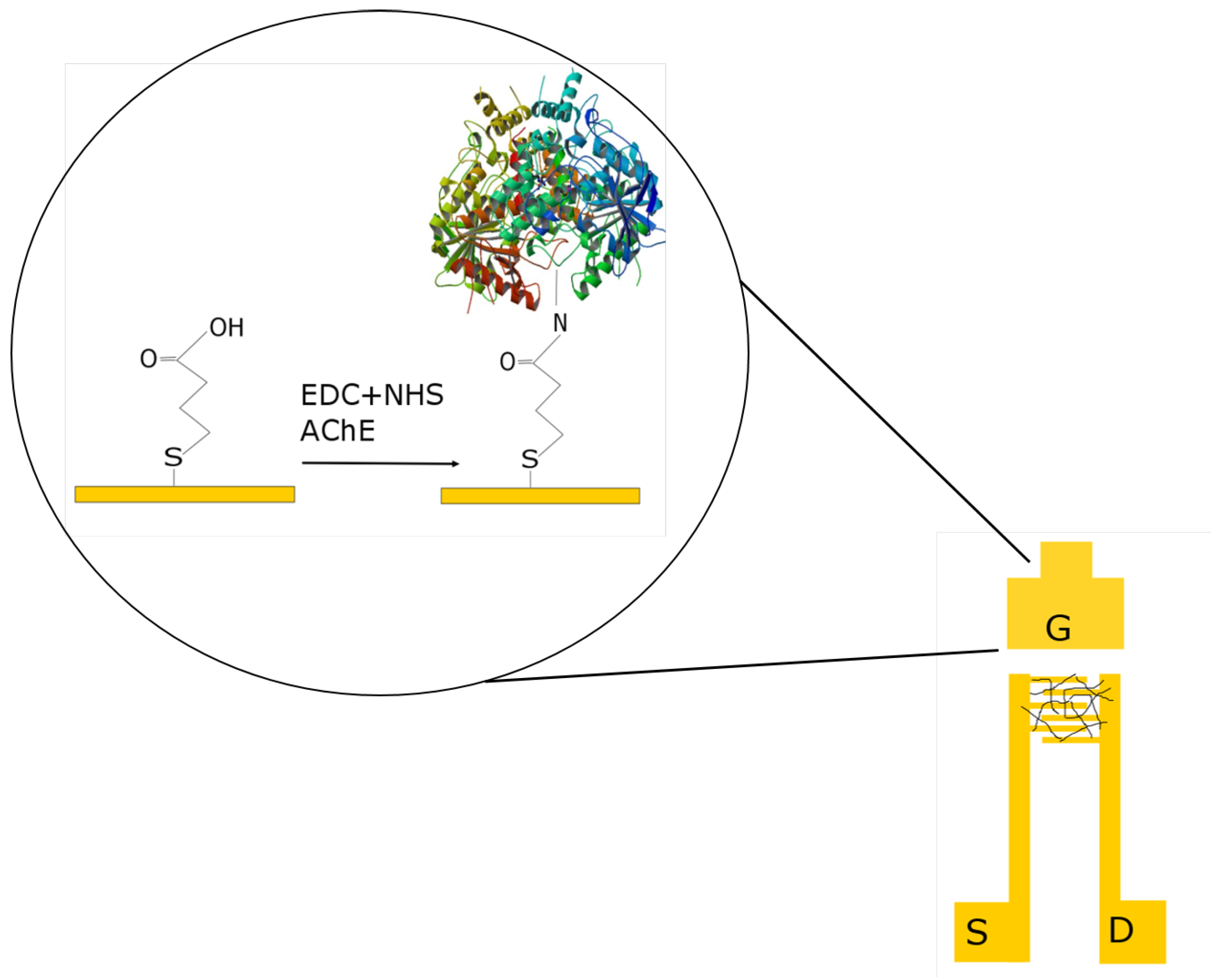

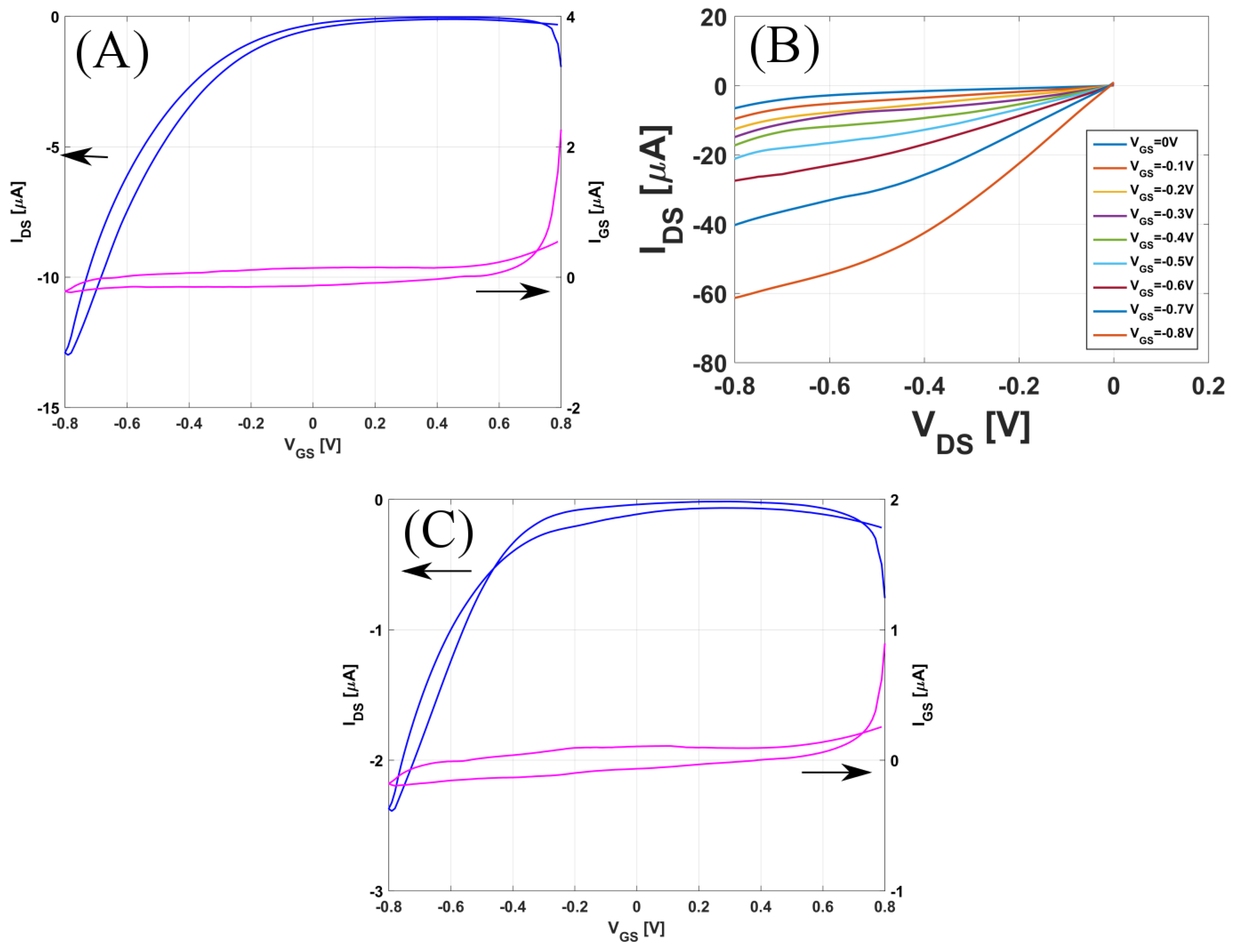
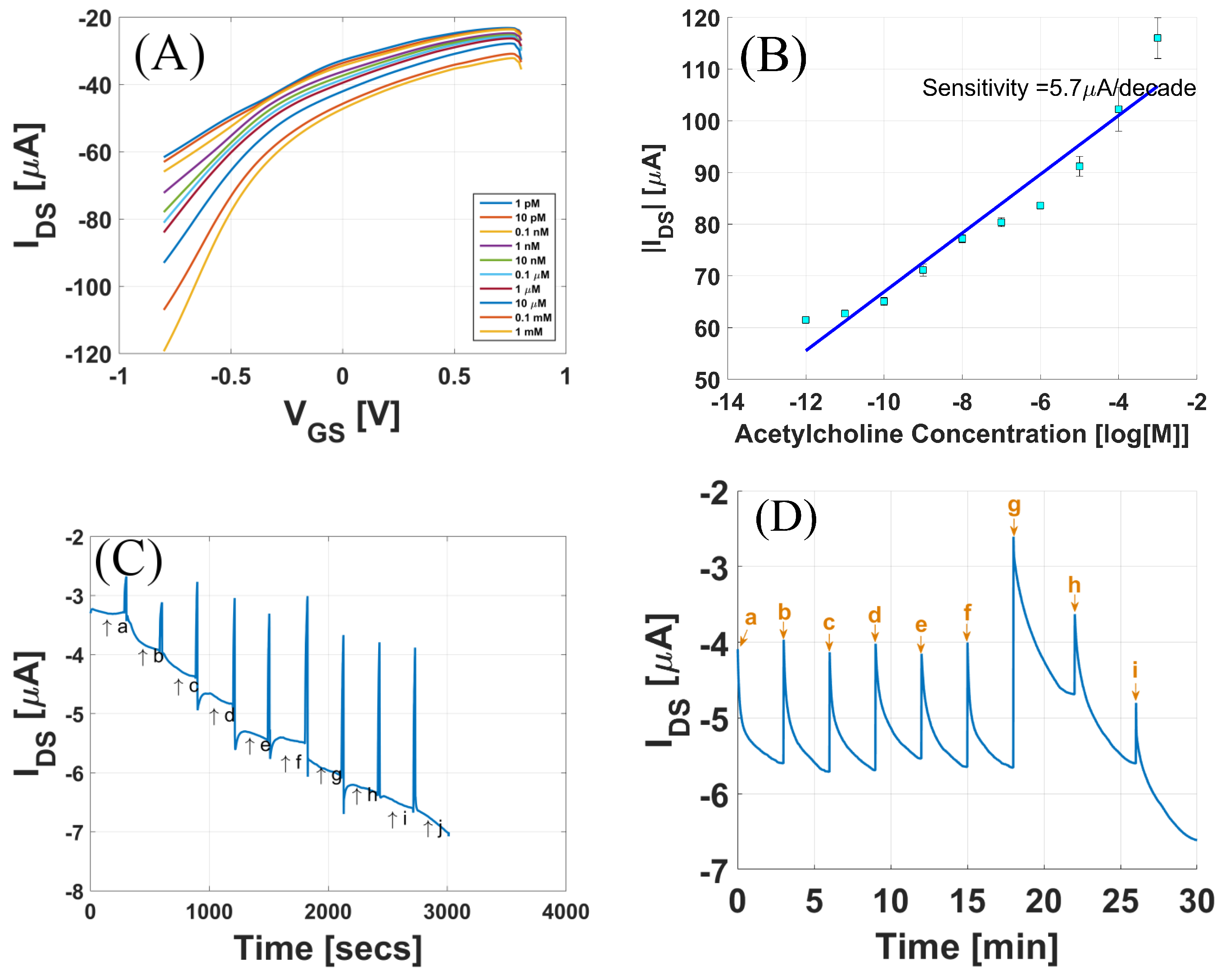
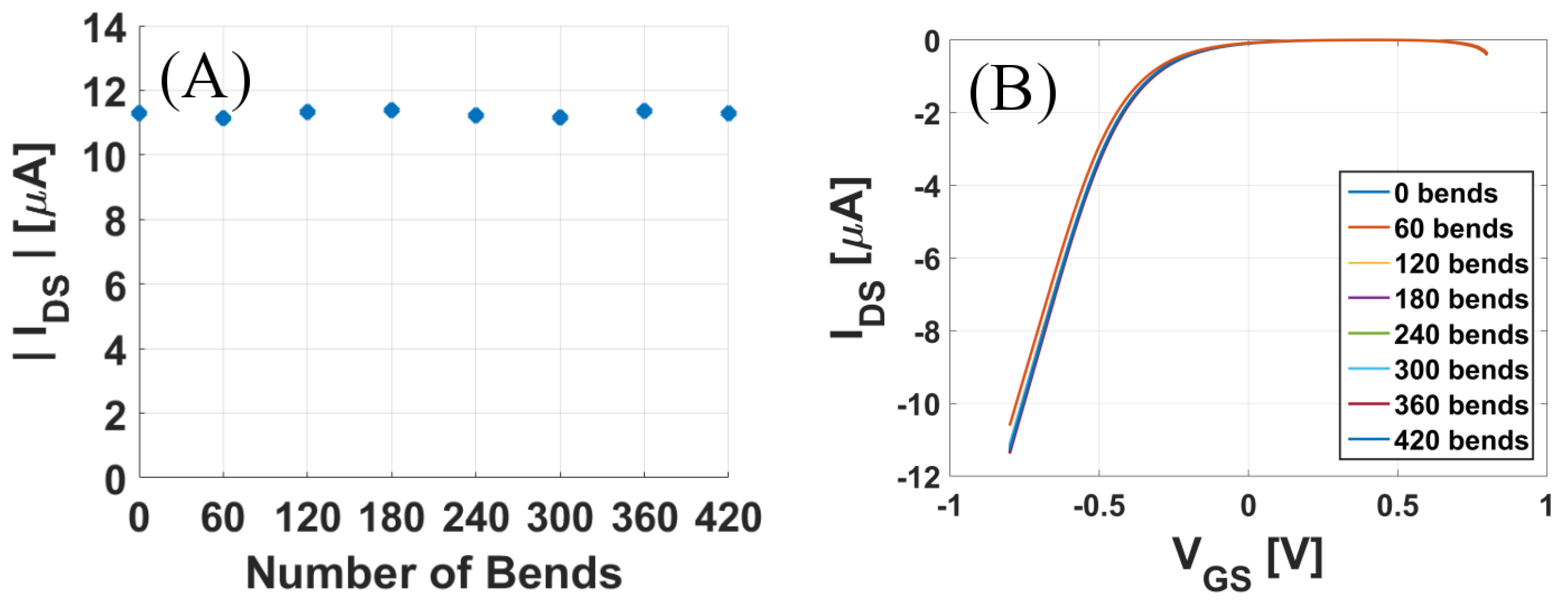
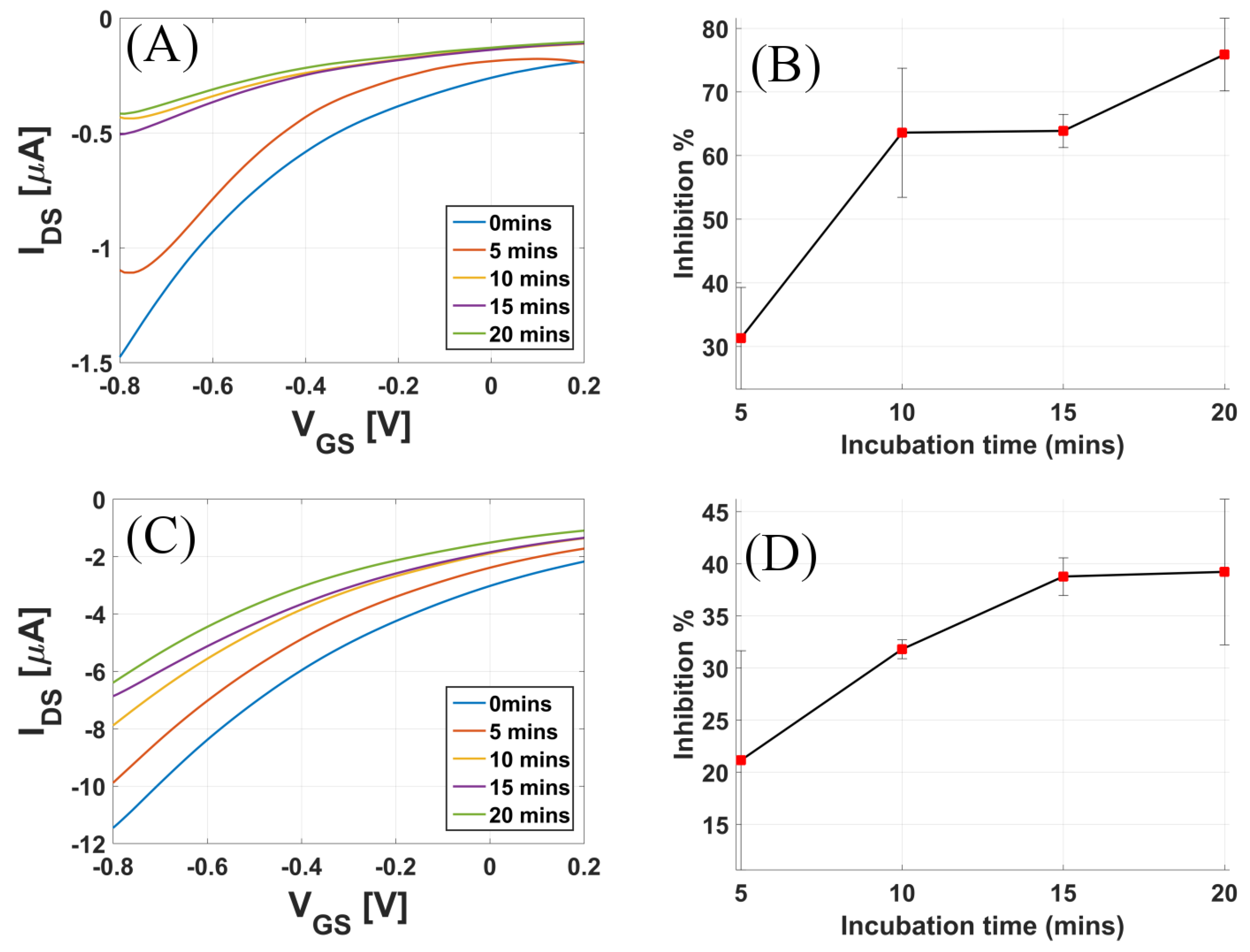
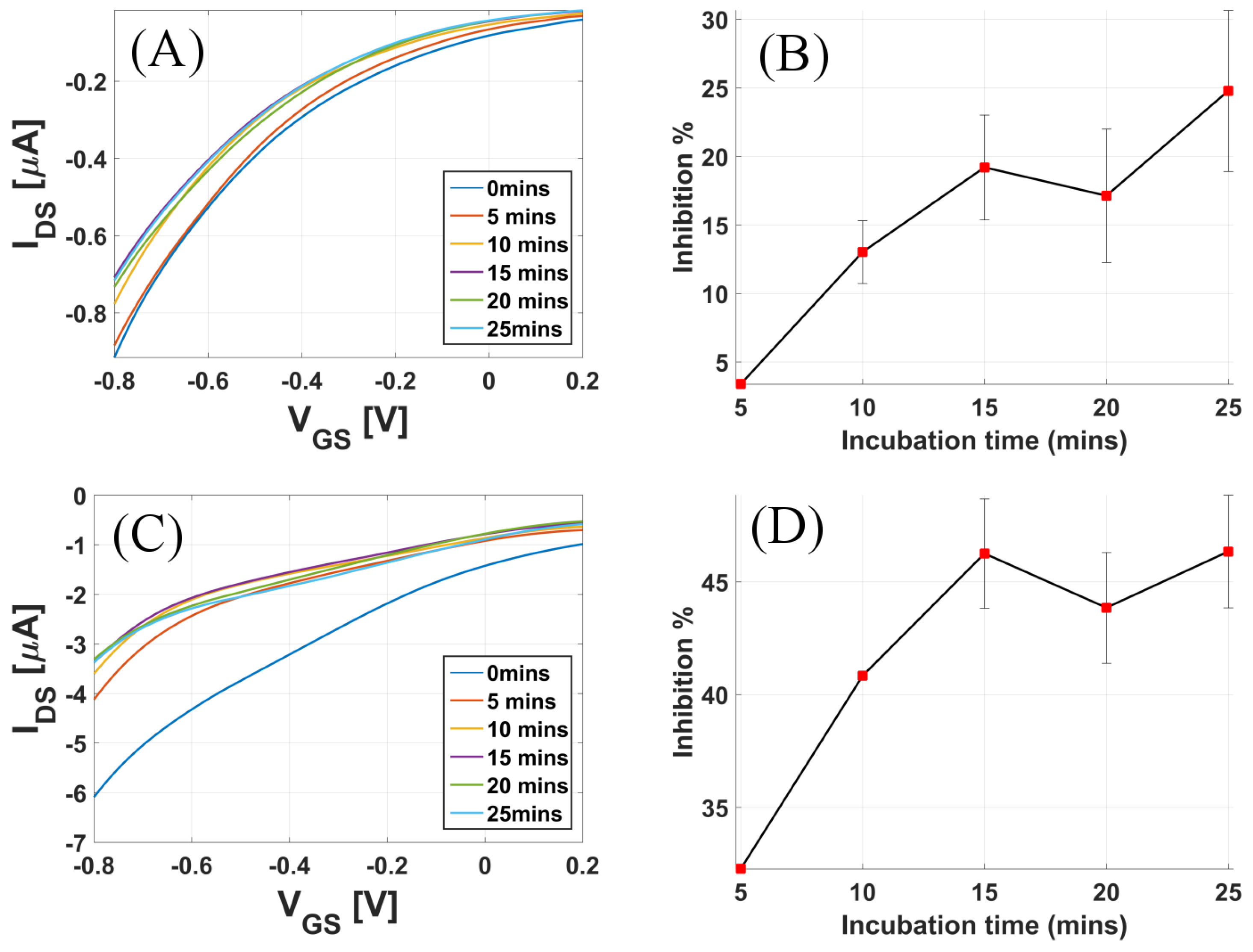
| Individual Concentrations of Species (M) | |||
|---|---|---|---|
| Solution | Serine | Glycine | Acetylcholine |
| a | 0.2 | 20 | 50 |
| b | 2 | 20 | 50 |
| c | 20 | 20 | 50 |
| d | 20 | 0.2 | 50 |
| e | 20 | 2 | 50 |
| f | 20 | 20 | 50 |
| g | 20 | 20 | 5 |
| h | 20 | 20 | 50 |
| i | 20 | 20 | 100 |
© 2017 by the authors. Licensee MDPI, Basel, Switzerland. This article is an open access article distributed under the terms and conditions of the Creative Commons Attribution (CC BY) license (http://creativecommons.org/licenses/by/4.0/).
Share and Cite
Bhatt, V.D.; Joshi, S.; Becherer, M.; Lugli, P. Flexible, Low-Cost Sensor Based on Electrolyte Gated Carbon Nanotube Field Effect Transistor for Organo-Phosphate Detection. Sensors 2017, 17, 1147. https://doi.org/10.3390/s17051147
Bhatt VD, Joshi S, Becherer M, Lugli P. Flexible, Low-Cost Sensor Based on Electrolyte Gated Carbon Nanotube Field Effect Transistor for Organo-Phosphate Detection. Sensors. 2017; 17(5):1147. https://doi.org/10.3390/s17051147
Chicago/Turabian StyleBhatt, Vijay Deep, Saumya Joshi, Markus Becherer, and Paolo Lugli. 2017. "Flexible, Low-Cost Sensor Based on Electrolyte Gated Carbon Nanotube Field Effect Transistor for Organo-Phosphate Detection" Sensors 17, no. 5: 1147. https://doi.org/10.3390/s17051147
APA StyleBhatt, V. D., Joshi, S., Becherer, M., & Lugli, P. (2017). Flexible, Low-Cost Sensor Based on Electrolyte Gated Carbon Nanotube Field Effect Transistor for Organo-Phosphate Detection. Sensors, 17(5), 1147. https://doi.org/10.3390/s17051147






